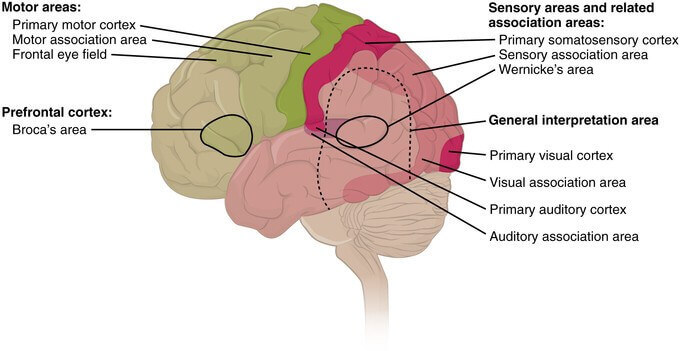
Note that HG in S2 is composed of a double peak, seen here as two light gray stripes, rather than the more common single gyrus. The exact location of this subject’s hA1 auditory field map is shown in red within the black dotted lines. Light gray regions denote gyri dark gray regions denote sulci. (B) The cortical surface of the left hemisphere of one subject (S2) is displayed as a typical inflated 3-D rendering created from high-resolution, anatomical MRI measurements. PAC: primary auditory cortex (red) LS: lateral sulcus (green also known as the lateral fissure or Sylvian fissure) CS: central sulcus (purple) STG: superior temporal gyrus (blue) STS: superior temporal sulcus (orange). Inset refers to anatomical directions as A: anterior P: posterior S: superior I: inferior. The white dotted line within the red region indicates the extension of PAC into the lateral sulcus (LS) along Heschl’s gyrus (HG hidden within the sulcus in this view). The approximate position of primary auditory cortex (PAC) is shown with the red overlay inside the black dotted line. (A) The lateral view of the left hemisphere is shown in the schematic. With the recent ability to measure AFMs in the core and belt regions of human auditory cortex along Heschl’s gyrus (HG) using high-resolution functional magnetic resonance imaging (fMRI), the stage is now set for investigation into this integration of basic auditory processing with higher-order auditory attention and working memory within human AFMs ( Figure 1). CFM organization likely serves as a framework for integrating bottom-up inputs from sensory receptors with top-down attentional processing.

CFMs within clusters tend to share properties such as receptive field distribution, cortical magnification, and processing specialization (e.g., ).Īcross the cortical hierarchy, there is generally a progressive increase in the complexity of sensory computations from simple sensory stimulus features (e.g., frequency content) to higher levels of cognition (e.g., attention and working memory). On a larger scale across cortex, AFMs are grouped into cloverleaf clusters, another fundamental organizational structure also common to visual cortex. In auditory cortex, auditory field maps (AFMs) are identified by two orthogonal sensory representations: tonotopic gradients from the spectral aspects of sound (i.e., tones), and periodotopic gradients from the temporal aspects of sound (i.e., period or temporal envelope). Accordingly neurons with receptive fields situated next to one another in sensory feature space are positioned next to one another in cortex within a CFM. The most fundamental sensory information is embodied by the organization of the sensory receptors, which is maintained throughout most of the cortical hierarchy of sensory regions with repeating representations of this topography in cortical field maps (CFMs). Mammalian sensory systems are composed in cortex of many functionally specialized areas organized into hierarchical networks. This chapter reviews current research into auditory nonverbal attention, auditory working memory, and auditory CFMs, and introduces the next steps to measure the effects of attention and working memory across the known auditory CFMs in human cortex using functional MRI.


Knowledge of the properties of such CFMs is the foundation for understanding the specific sensory computations carried out in particular cortical regions. The human auditory CFMs represent the spectral (i.e., tones) and temporal (i.e., period) aspects of sound, which are represented along the cortical surface as two orderly gradients that are physically orthogonal to one another: tonotopy and periodotopy, respectively. In at least the auditory and visual systems, the necessary computational steps to create these experiences take place in cloverleaf clusters of cortical field maps (CFMs). Computations that are common to these sensory systems include the abilities to maintain enhanced focus on particular aspects of incoming sensory information (i.e., attention) and to retain sensory information in a short-term memory store after such sensory information is no longer available (i.e., working memory).

Human sensory systems are organized into processing hierarchies within cortex, such that incoming sensory information is analyzed and compiled into our vivid sensory experiences.


 0 kommentar(er)
0 kommentar(er)
